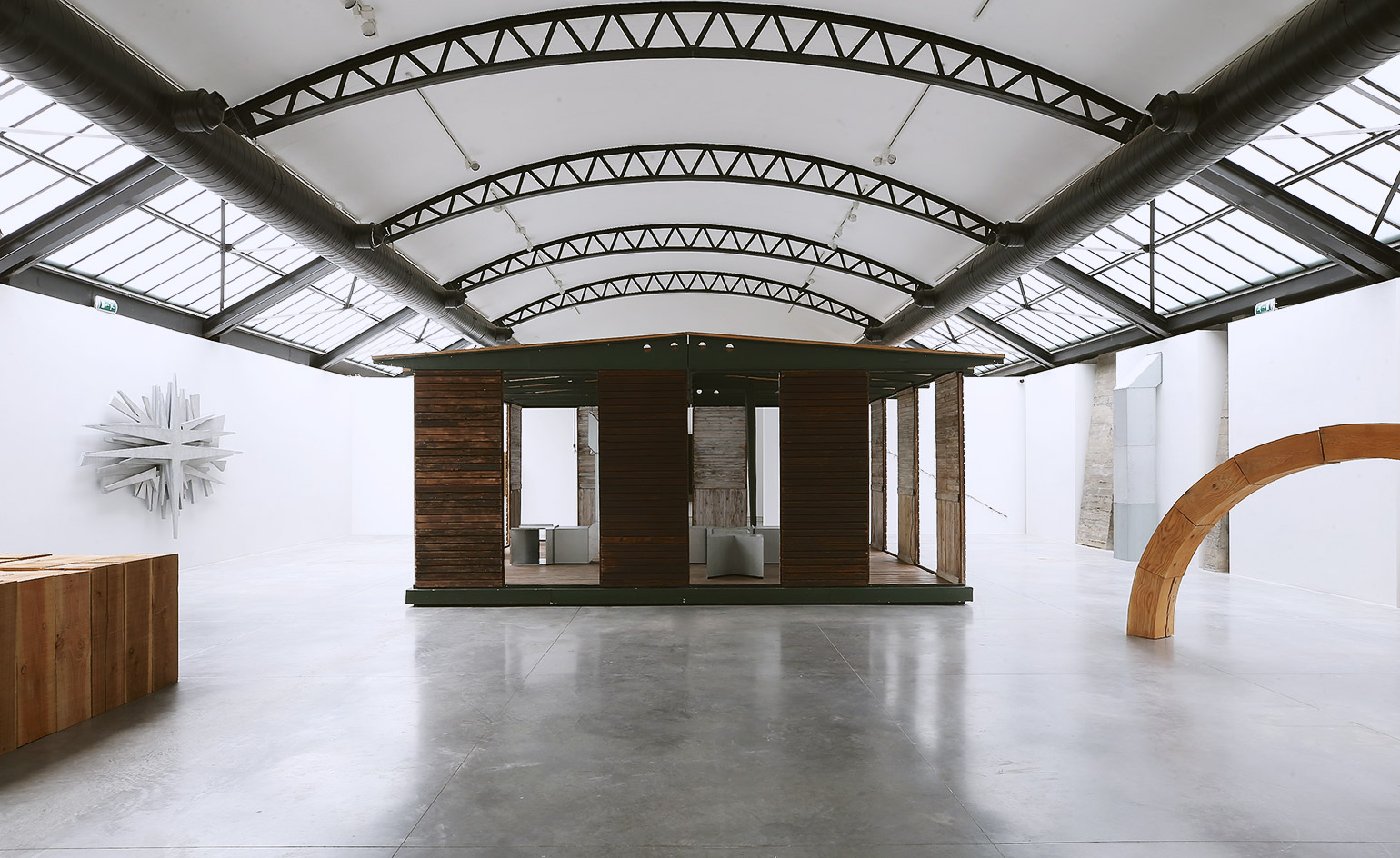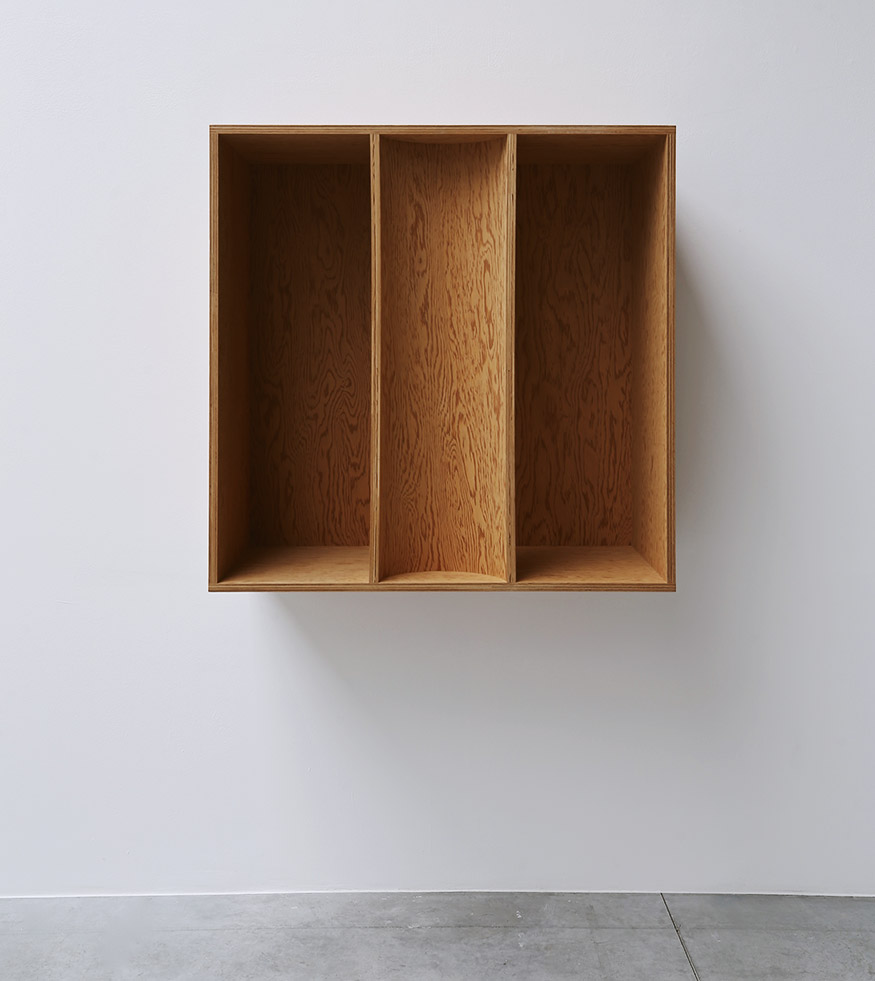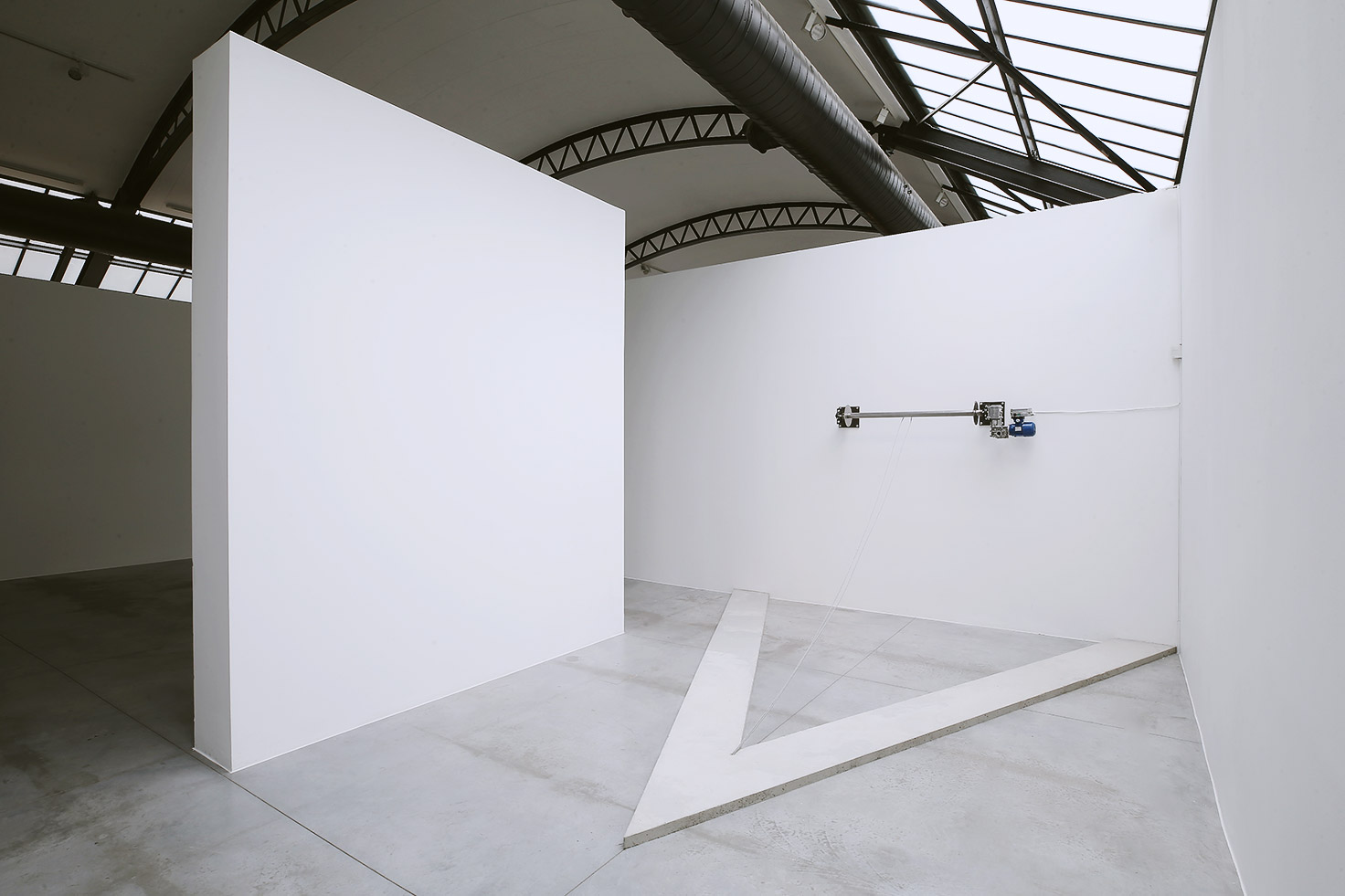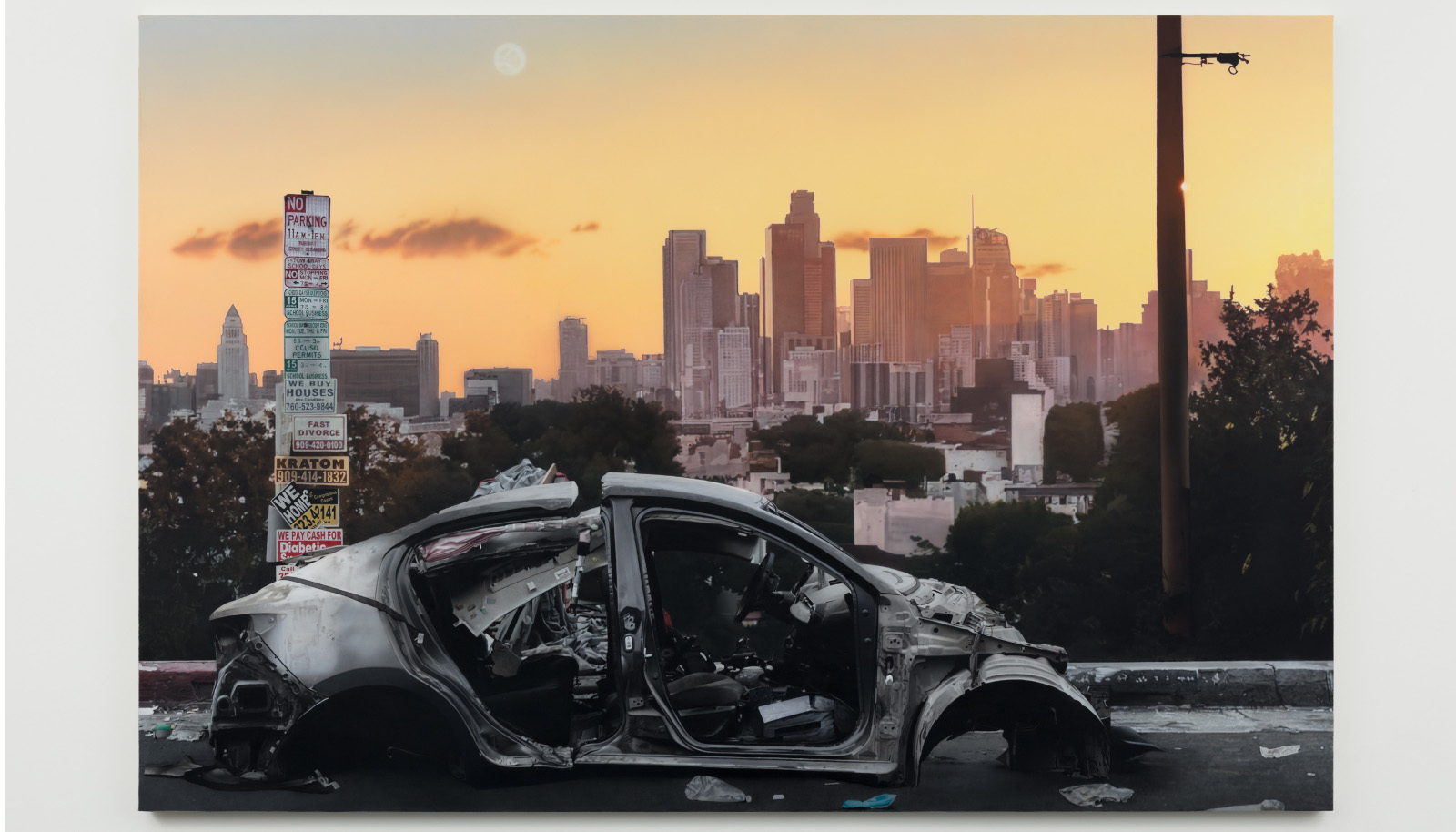Brutalist sculpture is the star act at this exhibition in Brussels

‘I have a strong credo that an exhibition must embody real objects,’ says curator Matthieu Poirier prefacing a walkthrough of ‘The Brutal Play’, in which works from Carl Andre, Donald Judd and Robert Morris occupy the Fondation CAB in Brussels. ‘These objects remind the viewers of their own bodies.’
The prolific contemporary curator who divides his time between the Belgian capital and Paris was given carte blanche by the non-profit contemporary art space (conceived by the ultra-private collector, Hubert Bonnet) to select works that bear witness to the visceral and material impact of minimalist forms. Even before arriving inside to the airy, 1930s-era warehouse converted by Olivier Dwek, visitors are confronted with a circle of inhospitable steel rebar erected by Karsten Födinger that obstructs the usual open entry. If not interactive, these works impose themselves through their volume and mass.
Which is not to say that that Poirier has selected them to make some highly formal statement, hence the show’s title. ‘We hear it as a game on brutalism, or else a play in the theatrical sense; and I like both those aspects because these sculptures take up space but they require that you move around them. They all imply free choreography on the part of the viewer; you’re not standing in front of a painting, you’re involved,’ he explains.

Scratch 2018, by Kilian Rüthemann, scratches on the wall; and Vierkantrohre Serie, 1967, by Charlotte Posenenske, reconstruction steel sheets. Courtesy of Fondation CAB/Brandajs
Visitors will quickly notice that the works are pretty much monochrome in nature. ‘There’s no makeup,’ he quips. ‘There is no pigment, as this is not about painting.’ As such, the overall statement feels coherent and elemental. The fact that a Demountable House (1944) from Jean Prouvé is permanently installed at the centre of the gallery establishes both a fixed point of departure and a decisive link between these structural works and architecture. ‘Another way to speak about minimalist sculpture is to put emphasis on the resonance between architecture and sculpture,’ Poirier confirms, noting how the genre began to emerge in the 1950s.
Accordingly, Roman Arch (2004) from Morris stands out as simultaneously symbolic and non-representational but can be appreciated simply by the way each oak block precariously remains in place. Andre’s 8 x 8 Cedar Solid comprising 64 blocks rising 90 cm high could delineate a small room or else just a cluster of tightly-packed monoliths.
He expresses considerable delight when showing off a series of small, freestanding blocky wood sculptures conceived by Rodchenko in 1920-21. Technically replicas, they have been accepted as originals. ‘That’s the logic of the artist — to make something that is essentially systematic,’ he says.
From here, it’s not a huge leap to the late German artist, Charlotte Posenenske, who Poirier considers a protagonist of this subject matter. Whereas her Square Tubes multiples appear deliberately disruptive within Prouvé’s house, her series of galvanised air ducts coexists with the gallery’s architecture when situated flush to the wall; and the contrast underscores Poirier’s own hand in shaping how visitors perceive differences in materiality – even when the artist source is the same.

Vierkantrohre Serie D, 1967, by Charlotte Posenenske, reconstruction steel sheets, housed in Maison Démontable 6x6, 1944, by Jean Prouvé. Courtesy of Fondation CAB/Brandajs
Interestingly, he also makes a point to show the vulnerability of the objects. A sarcophagus that Kilian Rüthemann carved on site from a giant block of foam has been stationed outside on a small terrace since the start of the show. Whereas concrete is impenetrable to the elements, its porous composition soaks up rainwater and gradually discolours yet remains resilient.
Then there is V, Ramon Feller’s concrete slab weighing one tonne and shaped as the title suggests, which has been hoisted from the ground by steel cables that lead to an electric motor. Over the course of the show, it has been rising ever so slowly from the ground and is programmed to self-destruct, or break, on the closing day. The added kinetic element in addition to the motor’s subtle hum introduce one final dimension to a multi-dimensional show.
Imagine, if you can, the constant force the motor must fight to lift the piece so incrementally. ‘Here, you really get the sense of time slowing down,’ says Poirier. ‘Everything today is about acceleration; I like deceleration – and the idea that this exhibition takes you out of the world.’ Except, of course, this would be discounting the reality of gravity, which as this play’s anti-hero, seems to exert an even stronger presence in the midst of such assertive, timeless forms.

Antecedent Reinforcement, 2018, by Karsten Födinger, steel. Courtesy of Fondation CAB/Brandajs

Speed and Aluminum and Trembling, 2017, by Valentin Carron, composite panels, acrylic paint (left), and Untitled, 91-7 Ballantine, 1991, by Donald Judd, Douglas Fir plywood. Courtesy of Fondation CAB/Brandajs

Untitled, 91-7 Ballantine, 1991, by Donald Judd, Douglas Fir plywood. Courtesy of Fondation CAB/Brandajs

Installation view of ‘The Brutal Play’ at Fondation CAB, Brussels. Courtesy of Fondation CAB/Brandajs

Installation view of ‘The Brutal Play’ at Fondation CAB, Brussels. Courtesy of Fondation CAB/Brandajs
INFORMATION
‘The Brutal Play’ is on view until 26 May. For more information, visit the Fondation CAB website
ADDRESS
Wallpaper* Newsletter
Receive our daily digest of inspiration, escapism and design stories from around the world direct to your inbox.
Fondation CAB
32-24 rue Borrens
1050 Brussels
-
 All-In is the Paris-based label making full-force fashion for main character dressing
All-In is the Paris-based label making full-force fashion for main character dressingPart of our monthly Uprising series, Wallpaper* meets Benjamin Barron and Bror August Vestbø of All-In, the LVMH Prize-nominated label which bases its collections on a riotous cast of characters – real and imagined
By Orla Brennan
-
 Maserati joins forces with Giorgetti for a turbo-charged relationship
Maserati joins forces with Giorgetti for a turbo-charged relationshipAnnouncing their marriage during Milan Design Week, the brands unveiled a collection, a car and a long term commitment
By Hugo Macdonald
-
 Through an innovative new training program, Poltrona Frau aims to safeguard Italian craft
Through an innovative new training program, Poltrona Frau aims to safeguard Italian craftThe heritage furniture manufacturer is training a new generation of leather artisans
By Cristina Kiran Piotti
-
 Artist Emmanuelle Castellan’s textural takeover in Brussels
Artist Emmanuelle Castellan’s textural takeover in BrusselsLa Verrière gallery in Brussels and Fondation d’entreprise Hermès present ‘Spektrum’, infused with colour and texture by the works of Emmanuelle Castellan
By Hannah Silver
-
 The ageing female body and the cult of youth: Joan Semmel in Belgium
The ageing female body and the cult of youth: Joan Semmel in BelgiumJoan Semmel’s ‘An Other View’ is currently on show at Xavier Hufkens, Belgium, reimagining the female nude
By Hannah Silver
-
 ‘Heaven ’N’ Earth’: Sayre Gomez blurs the reality and illusion of Los Angeles
‘Heaven ’N’ Earth’: Sayre Gomez blurs the reality and illusion of Los AngelesSayre Gomez’s ‘Heaven ‘N‘ Earth’ at Xavier Hufkens in Brussels explores the contrasts between wealth and poverty, reality and illusion in Los Angeles
By Finn Blythe
-
 Donald Judd’s home and studio in New York: celebrating 10 years
Donald Judd’s home and studio in New York: celebrating 10 yearsThe late Donald Judd’s home and studio in New York opened to the public in June 2013, after a three-year restoration process; we celebrate the occasion’s 10-year anniversary by revisiting our story from the archive
By Alice Rawsthorn
-
 Antony Gormley interview: ‘We’re at more than a tipping point. We’re in a moment of utter crisis’
Antony Gormley interview: ‘We’re at more than a tipping point. We’re in a moment of utter crisis’We visit the London studio of British sculptor Antony Gormley ahead of his major new show ‘Body Field’ at Xavier Hufkens Brussels
By Harriet Lloyd-Smith
-
 Food, sexuality and domesticity: Anthea Hamilton reconsiders the familiar in Antwerp
Food, sexuality and domesticity: Anthea Hamilton reconsiders the familiar in AntwerpSubversive and playful, Anthea Hamilton’s first survey exhibition, ‘Mash Up’ has opened at the Museum of Contemporary Art Antwerp
By Hannah Silver
-
 Rachel Eulena Williams weaves poetry and abstraction in Brussels
Rachel Eulena Williams weaves poetry and abstraction in BrusselsIn ‘Joy & Rain’ at Xavier Hufkens, Brussels, New York-based artist Rachel Eulena Williams presents new hybrid works that are bold, subversive and steeped in complex histories
By Harriet Lloyd-Smith
-
 New Hope is Brussels’ treasure trove of 20th century design
New Hope is Brussels’ treasure trove of 20th century designOlivier Dwek creates gallery New Hope, a treasure trove of 20th-century design in Brussels
By Amy Serafin